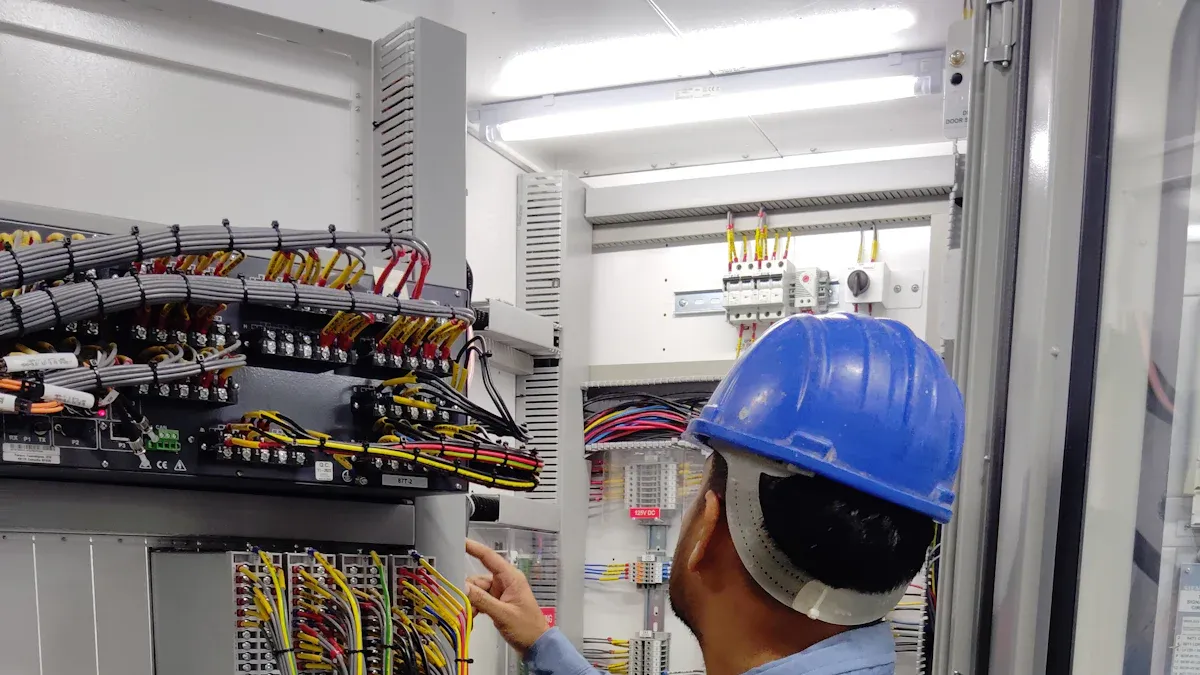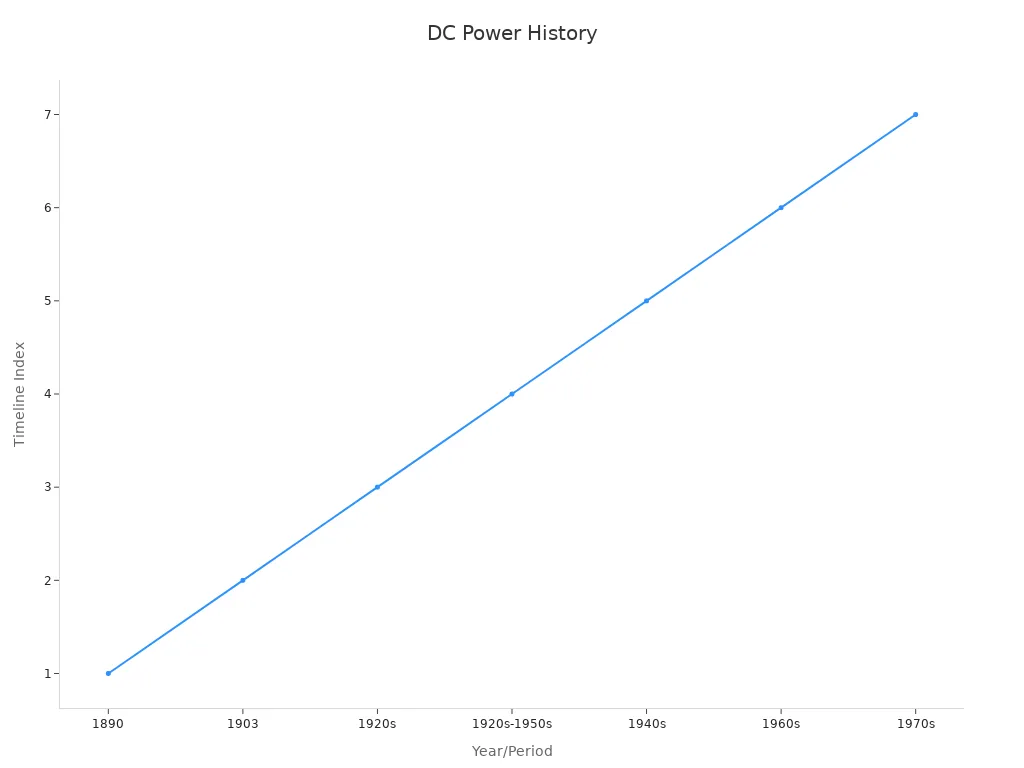What Are DC Power Systems in Telecom Applications

DC power plant telecom systems are the main support for telecom networks. These systems provide steady and reliable direct current (DC) energy to run important telecom tools. Without them, maintaining communication services would be very challenging.
You might wonder why DC power plant telecom systems are so crucial. Here’s why:
They lead the telecom power market and are projected to hold 64.5% by 2032.
Modern DC batteries can last over 10 hours during power outages, ensuring services continue to operate.
A well-designed DC power plant telecom setup helps operations run smoothly, reduces downtime, and saves energy. This makes it an essential component for today’s telecom industry.
Key Takeaways
DC power systems give steady energy to telecom networks. They keep communication working during power outages.
These systems use energy wisely, cutting waste and saving money for telecom companies over time.
DC power works well with green energy like solar and wind. This helps telecom companies be more eco-friendly.
Taking care of DC systems often is important. It stops problems and keeps them working for a long time.
Changing to DC power needs good planning. This is especially true when mixing with older AC systems.
Understanding DC Power Systems

What are DC power systems?
DC power systems are very important for telecom equipment. They give direct current (DC) electricity, which keeps telecom networks running. Unlike alternating current (AC), DC flows steadily without stopping. This makes it perfect for delicate telecom tools.
Why are DC power systems so important? They provide steady power to keep communication working. New telecom trends focus on saving energy and using smart features like remote monitoring. These updates make DC systems better and easier to handle.
Did you know? Managing DC power systems needs knowledge of parts like batteries and rectifiers. Experts are key to keeping these systems working well.
Key components of DC power systems
DC power systems have several parts that work together to stay reliable. Here’s a simple list of the main parts:
Rectifiers: Change AC power into DC power for telecom tools.
Batteries: Give backup power during blackouts to keep things running.
Power Distribution Units (PDUs): Send DC power to different telecom devices.
Controllers: Watch and manage the system, often with remote controls.
Cooling Systems: Stop parts from overheating to keep them working well.
Each part has a job to keep DC systems reliable. For example, modern batteries can last over 10 hours during blackouts, keeping telecom services running.
Title | Description |
|---|---|
Spacetime pq theory for AC and DC electric power systems | This paper explains a theory to help design and control both AC and DC power systems. |
How DC power systems function in telecom
In telecom, DC power systems turn AC power from the grid into DC power. This is needed because most telecom tools use –48 VDC. The process has a few steps:
AC to DC Conversion: Rectifiers change AC power into DC power.
Power Distribution: PDUs send the DC power to telecom tools.
Backup Systems: Batteries and generators give power during blackouts.
Monitoring and Control: Controllers check the system and warn about problems.
Diagrams often show how these parts work together, like rectifiers and batteries. They also show how backup systems keep things running during power failures.

DC power systems are not just for telecom but also for data centers and other important uses. Their steady and efficient power makes them a must-have in today’s telecom world.
Role of DC Power Systems in Telecom Applications

Keeping telecom systems reliable
DC power systems help telecom networks stay reliable. They keep working even during power outages. These systems give steady power, stopping downtime in cities and remote areas. Important tools like base stations and signal routers depend on DC power systems.
Why are DC power systems so dependable? Their design makes them strong. Unlike AC systems, DC systems skip extra power conversion steps. This simple setup lowers failure risks and boosts uptime. In 2023, DC power systems made up 63% of the telecom power market. This shows how important they are for keeping services running.
Tip: Using DC power systems can prevent service problems. They are key for telecom operations.
Helping important telecom equipment
Telecom tools need stable DC power to work well. DC systems give direct current to sensitive devices. They keep things running smoothly in data centers and base stations.
DC power has a big advantage. It works without stopping, even during power failures. Backup batteries and generators take over right away. This keeps telecom services active in tough times. DC systems also protect equipment from voltage changes. This saves money on repairs and makes devices last longer.
Note: DC power systems are great for areas with unstable electricity. They keep telecom tools working reliably.
Saving energy in telecom operations
Energy-saving is very important for telecom companies. DC power systems are good at saving energy. They skip extra power steps, cutting energy waste. This makes telecom operations more efficient.
DC systems also save money over time. Their simple design needs less wiring, lowering setup costs. They also reduce outages, improving energy use. DC systems are perfect for telecom companies wanting better performance and less environmental harm.
Did you know? DC power systems help save energy and support global eco-friendly goals. They are a smart choice for telecom’s future.
Advantages of Telecom DC Power Systems
Lower energy waste and better efficiency
DC power systems help save energy and work efficiently. Unlike AC systems, they skip constant AC-to-DC changes, which waste energy. Studies show DC microgrids lower costs by cutting energy waste. They also don’t need big converters, making them great for telecom use.
DC systems give steady voltage, keeping important tools stable. They avoid problems like voltage changes that harm telecom devices. Systems like Cence HV use lighter cables for high voltage. This reduces voltage drops and boosts safety and efficiency.
Easy connection with renewable energy
DC power works well with renewable energy like solar and wind. These sources make DC power, so no extra conversion is needed. This saves energy during power delivery.
Experts say DC systems help modernize grids and use renewables. They combine energy storage and smart tech to build green telecom networks. These systems improve efficiency and help create eco-friendly smart cities.
Saving money and growing with telecom needs
DC power systems save telecom companies a lot of money. Using energy-smart and hybrid systems lowers costs and energy use. Reports say hybrid power could save billions yearly in the telecom industry. Savings come from less energy waste, fewer repairs, and better equipment life.
DC systems are also easy to expand. They fit growing telecom needs with simple designs and fewer batteries. This lowers problems and ensures steady power. They are perfect for growing networks while keeping costs low.
Challenges in Using DC Power Systems
Working with older setups
Adding DC power systems to current telecom setups can be tricky. Many networks use old tools made for AC power. Switching to DC needs careful planning to avoid problems. Companies like ANS help by making special DC solutions for different setups. With over 30 years of experience, they make sure the change is smooth and works well.
Connecting DC systems to older devices can also be hard. Some older tools don’t work with DC power. This means extra converters or upgrades might be needed. These changes can cost more and take extra time. To fix these issues, telecom companies should check their setups and work with experts to find the best solutions.
Hard to install and keep working
Putting in DC power systems needs skill and planning. Telecom spaces are often small, making it harder to fit DC parts. As new tools take up more room, finding space for DC systems gets tougher. Careful design can help use space better.
Keeping DC systems working is also very important. Regular checks are needed to stop power problems. Skipping maintenance can cause failures and hurt telecom services. For example, batteries need checks to avoid overheating problems. By doing regular maintenance, you can make systems last longer and work better.
Dealing with rules and the environment
Using DC power systems means handling environmental and rule-based challenges. More power use from 5G networks could make cutting carbon emissions harder. Telecom power use might grow 170% by 2026, making it tough to meet EU’s 2030 carbon goals.
Rules like NEPA reviews make sure DC projects follow environmental standards. These reviews check for risks like harmful gas leaks from energy storage problems. Safety rules for batteries, like stopping overheating, are set by groups like the National Fire Protection Association. Following these rules helps make DC systems safe and eco-friendly.
Problem | Details |
|---|---|
More Power Use | 5G networks may raise power use by 170% by 2026. |
Small Spaces | New telecom tools make space tight, making DC system setup harder. |
Carbon Goals | Higher power needs may make EU’s 2030 carbon goals harder to reach. |
Tip: Work with rule-makers and use green practices to solve these problems well.
DC power systems are important for telecom. They keep networks running without interruptions, even during power outages. These systems also work well with renewable energy, saving money and helping the environment.
Here’s a simple list of their main benefits:
Benefit | Description |
|---|---|
Always Working | DC systems keep telecom services running without stopping. |
Protects Important Equipment | They shield telecom tools from power problems and blackouts. |
Saves Money | Using renewable energy with DC systems lowers costs a lot. |
Using DC power systems helps create a better and greener telecom network. They are key to handling the needs of today’s connected world.
FAQ
Why are DC power systems better than AC systems for telecom?
DC power systems give steady energy without stopping. This keeps sensitive telecom tools working well. Unlike AC systems, DC systems skip extra power changes. This saves energy and makes them more reliable.
How do DC power systems work with renewable energy?
Solar and wind power make DC energy directly. DC systems link to these sources without needing conversion. This saves energy and makes them great for green telecom setups.
Can DC power systems be used in remote telecom areas?
Yes, DC systems are great for faraway places. They provide backup power with batteries and generators. This keeps telecom services running even with bad electricity.
Tip: Pair DC systems with solar or wind power for better reliability in remote spots.
What care do DC power systems need?
Check batteries, rectifiers, and controllers often. This stops overheating and keeps them working well. Good care makes the system last longer and avoids problems.
Do DC power systems help save money in telecom?
Yes! DC systems waste less energy and need fewer parts. They work well with solar and wind power, cutting costs over time.
Note: Using DC systems saves money and helps telecom grow sustainably.
See Also
Essential Insights Into Telecom Power Supply Characteristics
An Introductory Overview of Telecom Power Supply Systems
Calculating Methods for Telecom Cabinet Power Systems and Batteries
Ensuring Consistent Power Supply for Telecom Cabinet Systems
CALL US DIRECTLY
86-13752765943
3A-8, SHUIWAN 1979 SQUARE (PHASE II), NO.111, TAIZI ROAD,SHUIWAN COMMUNITY, ZHAOSHANG STREET, NANSHAN DISTRICT, SHENZHEN, GUANGDONG, CHINA
